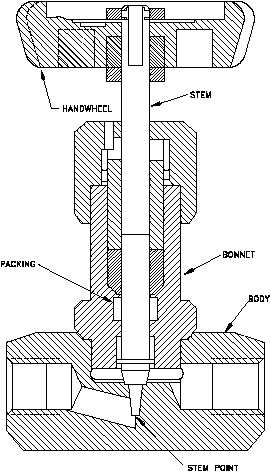Valves
DOE-HDBK-1018/2-93
TYPES OF VALVES
Stem seals are accomplished either with packing in a conventional stuffing box or by means of
O-ring seals. Some valve manufacturers, particularly those specializing in the handling of
corrosive materials, place a stem seal on the inside of the valve so that no material being
handled by the valve can come into contact with the valve stem. If a stuffing box or external
O-ring is employed, the fluid passing through the valve will come into contact with the valve
stem.
Needle Valves
Figure 20 Needle Valve
A needle valve, as shown in Figure 20, is
used to make relatively fine adjustments
in the amount of fluid flow.
The distinguishing characteristic of a
needle valve is the long, tapered, needle-
like point on the end of the valve stem.
This "needle" acts as a disk. The longer
part of the needle is smaller than the
orifice in the valve seat and passes
through the orifice before the needle
seats. This arrangement permits a very
gradual increase or decrease in the size of
the opening.
Needle valves are often
used as component parts of other, more
complicated valves. For example, they
are used in some types of reducing
valves.
Needle Valve Applications
Most constant pressure pump governors
have needle valves to minimize the effects
of fluctuations in pump discharge
pressure. Needle valves are also used in
some
components
of
automatic
combustion control systems where very
precise flow regulation is necessary.
Rev. 0
ME-04
Page 33


